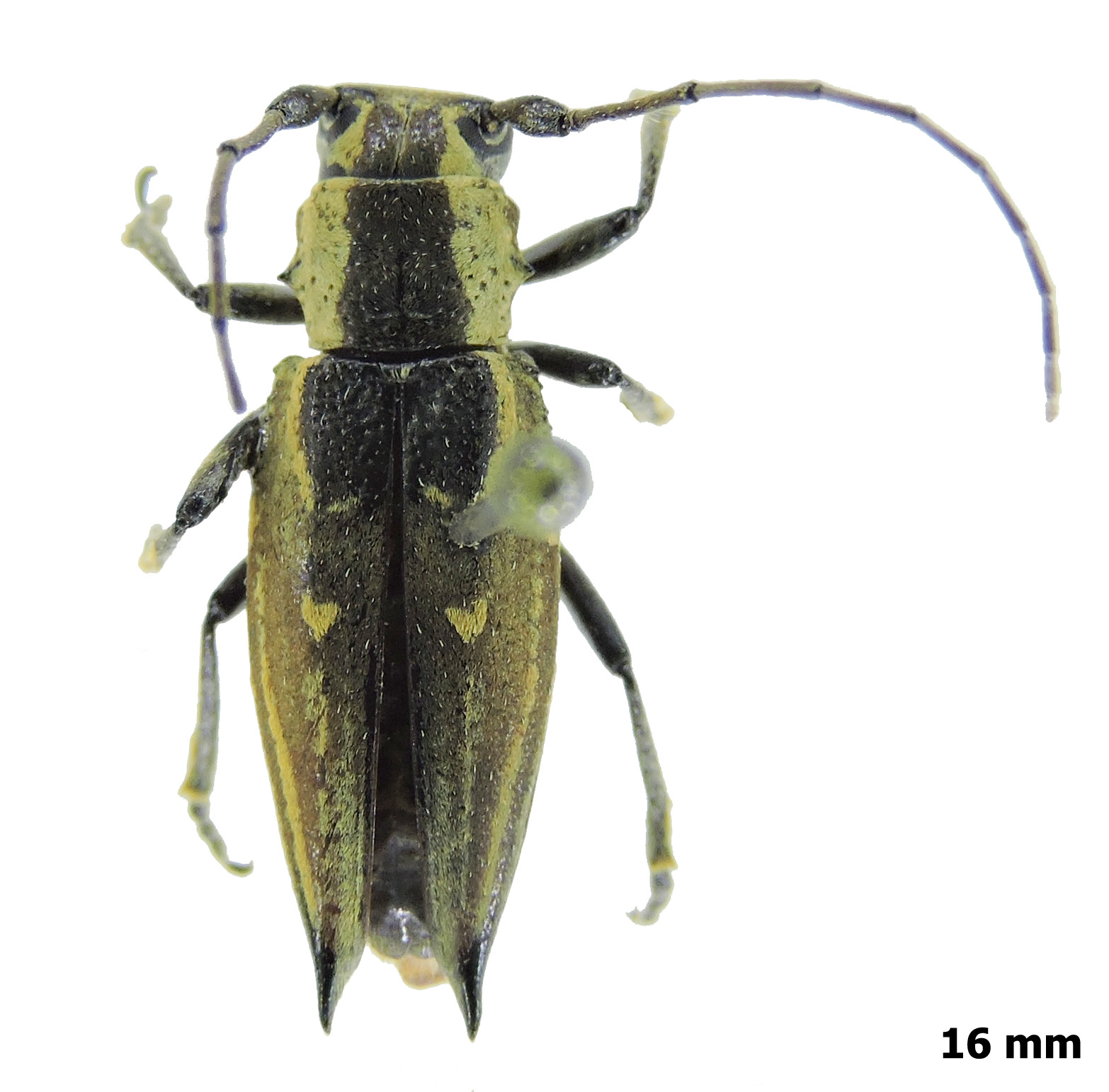| Author |
 Topic Topic  |
|
|
sangamesh
Member Purpuricenus
 
India
426 Posts |
 Posted - 10/02/2017 : 20:03:44 Posted - 10/02/2017 : 20:03:44



|

344.11 KB
Received this specimen (collected during 2012) from a colleague for my studies... Loc: Kerala; there are two species known from India (both species coming from Kerala) viz., Notomulciber (Micromulciber) travancorensis Breuning, 1958 and Notomulciber (Micromulciber) decemmaculatus Breuning, 1942... obviously it is not the latter species...
I do not know the former species nor have the original description to compare... suggestions are welcome on the identity...
Thank you |
Edited by - sangamesh on 18/02/2019 08:24:53 |
|
|
Xaurus
Member Rosenbergia
   
Germany
1891 Posts |
 Posted - 11/02/2017 : 00:31:06 Posted - 11/02/2017 : 00:31:06



|
| this belongs to the genus Grynex Pascoe, 1888 |
 |
|
|
sangamesh
Member Purpuricenus
 
India
426 Posts |
 Posted - 11/02/2017 : 07:46:42 Posted - 11/02/2017 : 07:46:42



|
How do one separate Micromulciber and Grynex ... ...
Following the description of Pascoe (1867: 453) here Micromulciber is defined to have the elytral apex obliquely emarginate and 'ending externally in a stout point' and Pascoe (1888: 502) defines here Grynex as having elytral apex obliquely incised and 'tapering to an obtuse point at apex'...the description of other characters also seems to fit one another ...are there real characters by which these two are differentiated??...Please clarify if I'm mistaken... ...are there real characters by which these two are differentiated??...Please clarify if I'm mistaken... |
Edited by - sangamesh on 11/02/2017 07:49:48 |
 |
|
|
Francesco
Forum Admin
    
Luxembourg
9402 Posts |
 Posted - 11/02/2017 : 09:12:51 Posted - 11/02/2017 : 09:12:51




|
According to Breuning's revision (1950), Notomulciber shows a rounded prosternum, while Grynex shows a prosternum vertically truncated posteriorly.
Have you got that revision? |
 |
|
|
Xavier
Scientific Collaborator
    
France
12002 Posts |
 Posted - 11/02/2017 : 09:58:54 Posted - 11/02/2017 : 09:58:54



|
| In Breuning, 1950. Revision des Homonoeini. description of Paragrynex ochreosparsus Breuning, 1940 fits quite well with your specimen. |
 |
|
|
sangamesh
Member Purpuricenus
 
India
426 Posts |
 Posted - 11/02/2017 : 10:30:40 Posted - 11/02/2017 : 10:30:40



|
| Thank you very much for all the inputs...I do not have the copy of Breunings revision...can you please share the file... |
 |
|
|
Xavier
Scientific Collaborator
    
France
12002 Posts |
 Posted - 11/02/2017 : 11:20:24 Posted - 11/02/2017 : 11:20:24



|
It is done  |
 |
|
|
sangamesh
Member Purpuricenus
 
India
426 Posts |
 Posted - 11/02/2017 : 11:30:56 Posted - 11/02/2017 : 11:30:56



|
quote:
Originally posted by Xavier
It is done 
Thank you very much |
 |
|
|
sangamesh
Member Purpuricenus
 
India
426 Posts |
 Posted - 11/02/2017 : 17:15:38 Posted - 11/02/2017 : 17:15:38



|

523.59 KB
The specimen completely agrees with the genus description but there are some striking features in the specimen posted here compared to the only species known within this genus...as you can see in the lateral aspect of the specimen (image attached) I could enlist following characters not mentioned in the description of the species ochreosparsus...
- There are distinct tubercles on the humeral prominence
- there is almost circular greyish yellow spot, a quarter away from the humeral prominence
- in the same line, there is an oblong short band present just behind the middle, followed by a greyish longitudinal line approaching towards elytral apex
- lateral margins of elytra provided with interrupted band of greyish yellow pubescence
So, considering the above points, whether it remains the same species? |
Edited by - sangamesh on 11/02/2017 17:20:22 |
 |
|
|
Xaurus
Member Rosenbergia
   
Germany
1891 Posts |
 Posted - 12/02/2017 : 00:50:52 Posted - 12/02/2017 : 00:50:52



|
I'll check my database to find a picture of this sps later.
Breuning's key to differentiate the Homonoenini genera you can forget completely is like a lottery  . .
|
 |
|
|
Xavier
Scientific Collaborator
    
France
12002 Posts |
 Posted - 12/02/2017 : 08:22:56 Posted - 12/02/2017 : 08:22:56



|
| ... and I proposed this name by reading the description, but I haven't seen holotype to prove anything. |
 |
|
|
Xavier
Scientific Collaborator
    
France
12002 Posts |
 Posted - 12/02/2017 : 08:43:41 Posted - 12/02/2017 : 08:43:41



|

Original description from BREUNING S., 1940.Novae species Cerambycidarum. IX. Folia Zoologica et Hydrobiologica, Riga 10 (1): 115-214.
I do not know if the German text is the same as French one. |
 |
|
|
sangamesh
Member Purpuricenus
 
India
426 Posts |
 Posted - 12/02/2017 : 16:50:34 Posted - 12/02/2017 : 16:50:34



|
I think both text (German and French) speak about the same characters (courtesy of google translator)...
quote:
I'll check my database to find a picture of this sps later
That would be very helpful |
 |
|
|
Xaurus
Member Rosenbergia
   
Germany
1891 Posts |
 Posted - 13/02/2017 : 00:54:16 Posted - 13/02/2017 : 00:54:16



|
| from the descriptions ok you can find in many cases a satisfied ID but the keys are almost useless. |
 |
|
|
sangamesh
Member Purpuricenus
 
India
426 Posts |
 Posted - 18/02/2019 : 08:34:47 Posted - 18/02/2019 : 08:34:47



|
quote:
Originally posted by Xaurus
this belongs to the genus Grynex Pascoe, 1888
This species does not belong to Paragrynex...I agree with the suggestion that this species should belong to Grynex...
Both the genera can be differentiated based on the nature of prosternal process: in the Paragrynex prosternal process is lower than the fore-coxae and arcuate in lateral view, whereas, it is elevated, as high as fore-coxae and posteriorly truncated in lateral view in Grynex...this species agrees with the character of the genus Grynex and it is close to G. martini (Allard, 1894). |
Edited by - sangamesh on 18/02/2019 08:36:42 |
 |
|
| |
 Topic Topic  |
|


